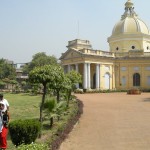Heritage Walk to Kashmiri gate & neighbourhood, 25 April 2010
This heritage walk covers the modern neighbourhood of Kashmiri Gate near the ISBT. Most of the sites here relate to first half of 18th century and some specific events associated with the revolt of 1857. In the 17th century this area was part of the Mughal capital of Shahjahanabad, what is today old Delhi. Kashmiri gate has mansions of some important personalities associated with the Mughal court like, Ali Mardan Khan, the noble who was instrumental in building canals which brought water to the city and Dara Shukoh, Shahjahan’s son. Later, the British started living in this neighbourhood. It is their buildings which mostly survive now.
We started the heritage walk from Nicholson’s cemetery. John Nicholson was a British general, instrumental in breaching the defenses of rebels who were controlling Delhi, and in the process lost his life. The cemetery is named after him, but there are other important people buried here as well. Master Ramachandra, the Professor of Mathematics associated with the Delhi College is buried here. Next stop was the Kashmiri gate. It is one of the surviving city gates which give the neighbourhood its name. There are some city walls which can be seen in the area, but they are mostly hidden by modern buildings. A little ahead is the Lal Masjid, built by a lady in memory of her husband who was a general under Emperor Aurangzeb and died in a battle. It is an 18th century structure. The market on this road has some traces of colonial architecture which are only visible if one looks carefully through the shop hoardings. The old St. Stephen’s college & old Hindu college buildings stand adjacent to each other. Across the road is St. James’ Church, the oldest church in Delhi, built by James Skinner of Skinner’s Horse. It is a well maintained complex which has the family burial ground of the Skinners & William Fraser’s grave. The church suffered severe damage in 1857 fighting.
The Residency building, built on what is traditionally believed to be Dara Shukoh’s library was to be the next stop but to everyone’s disappointment, we could not see it. It is now part of Indraprastha University’s campus and apparently a group of heritage walkers on Sunday morning posed a serious threat to the University’s well being. It is such a pity that parts of the city are becoming more and more inaccessible to public, all in name of maintaining security.
Still, we walked ahead to an island on the road opposite the post office. This has the telegraph memorial and remains of the British magazine which was blown up by the officers defending it when they couldn’t hold out any longer. At the end of road is the Lothian road cemetery the oldest British cemetery in the city.
(posted by Rajesh Ranjan & Kanika Singh, team members, Delhi Heritage Walks)








